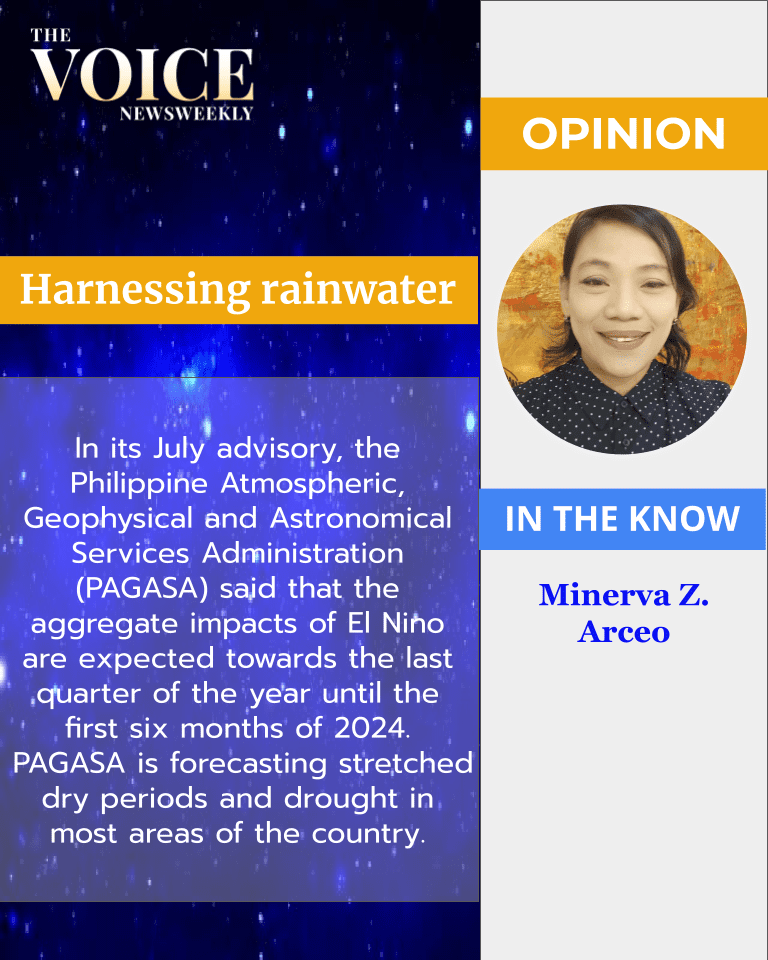𝗜𝗻 𝘁𝗵𝗲 𝗞𝗻𝗼𝘄 𝗯𝘆 𝗠𝗶𝗻𝗲𝗿𝘃𝗮 𝗭. 𝗔𝗿𝗰𝗲𝗼
In its July advisory, the Philippine Atmospheric, Geophysical and Astronomical Services Administration (PAGASA) said that the aggregate impacts of El Nino are expected towards the last quarter of the year until the first six months of 2024. PAGASA is forecasting stretched dry periods and drought in most areas of the country.
The imminent threat of El Nino is a real challenge to local government units (LGUs), especially in highly-urbanized areas like Metro Manila, Metro Cebu, Baguio City and even Angeles City. These cities are included in the list of critical areas identified by the Japan International Cooperation Agency (JICA) that are at high risk of losing water by 2025. JICA conducted studies on water security in 1998 and in 2011 in cooperation with the National Water Resources Board (NWRB).
In the 2011 report, JICA came up with an integrated water resources management plan for Pampanga, Bulacan, Tarlac and Nueva Ecija. It covers the development of irrigation for agriculture and fishery, development of bulk water systems and municipal sewerage, management of watersheds and management of floods and sediment disasters.
The NWRB and the Department of Environment and Natural Resources (DENR) are partly implementing the blueprint through the National Greening Program (NGP) but majority of the recommended mitigation projects are still in paper.
In the Metro Clark Area (including Mabalacat City) and Angeles City alone, there is an urgency to develop bulk water systems to harness rainwater and to use surface water from the Sacobia River, Marimla River, Porac-Gumain River or the Pampanga River. Also, centralized wastewater treatment plants are needed to recycle industrial water so as to mitigate the impact of a projected water shortage.
The Angeles City government led by Mayor Carmelo G. Lazatin Jr., has initiated a massive reforestation program in partnership with the private sector groups led by the Abacan River and Angeles Watershed Advocacy Council, Inc. (ARAW-ACI). The goal is to rehabilitate the Angeles Watershed in Sapangbato and enhance water replenishment and re-charge.
The reforestation program is just one of the many solutions to the impending water problem. Recycling industrial wastewater and developing the bulk water systems are part of the long-term solutions that need to be done.
In the meantime, there are options that LGUs can do speedily to lessen the impacts of the prolonged El Nino.
The LGUs can ask the Department of Public Works and Highways (DPWH) to construct water wells and rainwater collectors in every barangay pursuant to Republic Act 6716, also known as the Rainwater Collector and Springs Development Act of 1989.
This is an existing law that has been totally ignored or forgotten.
RA 6716 requires the construction of rainwater collectors in every barangay to prevent flooding and ensure the continuous provision of clean water during dry season. It is also intended to help alleviate water scarcity.
Section 2 of RA 6716 clearly states that the construction shall be undertaken by the DPWH. The agency is tasked to construct water wells and rainwater collectors, develop springs and rehabilitate existing water wells in all barangays in the Philippines. The funding will come from the national government and from a portion of financial grants and concessional loans extended to the Philippines by foreign governments.
And so, while waiting for the realization of long-term mitigation projects, LGUs can start practicing rainwater collection as an immediate and practical solution to the expected water shortage.













